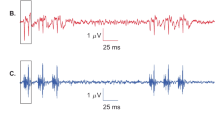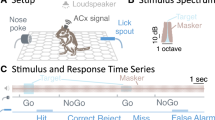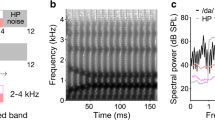Abstract
Envelope temporal fluctuations are critical for effective processing of biologically relevant sounds including speech, animal vocalizations, sound-source location and pitch. Amplitude modulation (AM) of sound envelopes can be encoded in quiet with high fidelity by some auditory neurons, including those of the cochlear nucleus. From both neurophysiological and clinical perspectives, it is important to understand the effects of background noise on the processing of AM. To further this goal, single-unit recordings were made from dorsal cochlear nucleus (DCN) units in urethane-anesthetized chinchillas. All units of this study were classified as pauser/buildup or On-s units according to PSTH response patterns, first spike latencies, and shape of best-frequency (BF) rate-intensity functions. BF puretone and AM (10–500 Hz) tone bursts were presented at several sound levels, in quiet and in the presence of a continuous wideband masker. The following was found: (1) DCN units can enhance their AM coding relative to quiet in the presence of loud noise (+14 or +19 dB S/N) and at high signal levels (e.g. 75 dB SPL); (2) for the sample of units of the present study, this is usually achieved by lowering the average firing rate and increasing the synchronous (fundamental frequency) response; (3) for some units, the AM coding stays the same or declines in the background noise. The nature of these findings suggests that part of a DCN unit's abilities to preserve or enhance AM coding with masking noise results from peripheral operating range shifts, whereas part comes from intrinsic circuitry (inhibitory inputs) or cellular mechanisms (dendritic filtering of sound temporal features) within the DCN.
Similar content being viewed by others
References
Cooper NP, Robertson D, Yates GK (1993) Cochlear nerve fiber responses to amplitude-modulated stimuli: variations with spontaneous rate and other response characteristics. J Neurophysiol 70:370–386
Frisina RD, Walton JP (1991) Processing of rapid changes in sound amplitude in the cochlear nucleus in quiet and the presence of noise (abstract). World Congress of International Brain Research Organization 3:250
Frisina RD, Chamberlain SC, Brachman ML, Smith RL (1982) Anatomy and physiology of the gerbil cochlear nucleus: an improved surgical approach for microelectrode studies. Hearing Res 6:259–275
Frisina RD, Smith RL, Chamberlain SC (1985) Differential encoding of rapid changes in sound amplitude by second-order auditory neurons. Exp Brain Res 60:417–422
Frisina RD, O'Neill WE, Zettel ML (1989) Functional organization of mustached bat inferior colliculus. II. Connections of the FM2 region. J Comp Neurol 284:85–107
Frisina RD, Smith RL, Chamberlain SC (1990a) Encoding of amplitude modulation in the gerbil cochlear nucleus. I. A hierarchy of enhancement. Hearing Res 44, 99–122
Frisina RD, Smith RL, Chamberlain SC (1990b) Encoding of amplitude modulation in the gerbil cochlear nucleus. II. Possible neural mechanisms. Hearing Res 44:123–141
Frisina RD, Walton JP, Karcich KJ (1993) Differential abilities to extract sound-envelope information by auditory nerve and cochlear nucleus neurons. In: Verrillo RT (ed) Sensory research: multimodal perspectives. L Erlbaum, Hillsdale, NJ, pp 151–175
Gibson DJ, Young ED, Costalupes JA (1985) Similarity of dynamic range adjustment in auditory nerve and cochlear nuclei. J Neurophysiol 53:940–958
Joris PX, Yin TCT (1992) Responses to amplitude-modulated tones in the auditory nerve of the cat. J Acoust Soc Am 91:215–232
Kim DO, Sirianni JG, Chang SO (1990) Responses of DCNPVCN neurons and auditory nerve fibers in unanesthetized decerebrate cats to AM and pure tones: analysis with autocorcorelation. Hearing Res 45:95–113
Langner G (1981) Neuronal mechanisms for pitch analysis in the time domain. Exp Brain Res 44:450–454
Langner G (1992) Periodicity coding in the auditory system. Hearing Res 60:115–142
Langner G, Schreiner CE (1988) Periodicity coding in the inferior colliculus of the cat. I. Neuronal mechanisms. J Neurophysiol 60:1799–1822
Lesser HD, O'Neill WE, Frisina RD, Emerson RG (1990) On-off units in the mustached bat inferior colliculus are selective for transients resembling acoustic glint from fluttering insect targets. Exp Brain Res 82:137–148
Møller AR (1972) Coding of amplitude and frequency modulated sounds in the cochlear nucleus of the rat. Acta Physiol Scand 86:223–238
Rees A, Møller AR (1983) Responses of neurons in the inferior colliculus of the rat to AM and FM tones. Hearing Res 10:301–330
Rees A, Møller AR (1987) Stimulus properties influencing the responses of inferior colliculus neurons to amplitude-modulated sounds. Hearing Res 127:129–143
Rees A, Palmer AR (1989) Neuronal responses to amplitude-modulated and pure-tone stimuli in the guinea pig inferior colliculus, and their modification by broad-band noise. J Acous Soc Am 85:1978–1994
Schreiner CE, Langner G (1988) Periodicity coding in the inferior colliculus of the cat. II. Topographical organization. J Neurophysiol 60:1823–1840
Schreiner CE, Snyder R (1987) Modulation transfer characteristics of neurons in the dorsal cochlear nucleus of the cat. Soc Neurosci Abstr 13:1258
Smith RL, Brachman ML (1980) Response modulation of audito-nerve fibers by AM stimuli: effects of average intensity. Hearing Res 2:123–144
Vater M (1982) Single unit responses in cochlear nucleus of horseshoe bats to sinusoidal frequency and amplitude modulated signals. J Comp Physiol A 149:369–388
Author information
Authors and Affiliations
Rights and permissions
About this article
Cite this article
Frisina, R.D., Walton, J.P. & Karcich, K.J. Dorsal cochlear nucleus single neurons can enhance temporal processing capabilities in background noise. Exp Brain Res 102, 160–164 (1994). https://doi.org/10.1007/BF00232448
Received:
Accepted:
Issue Date:
DOI: https://doi.org/10.1007/BF00232448




